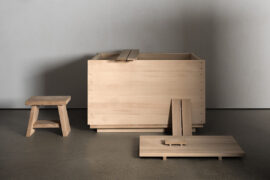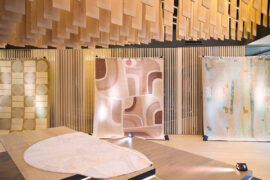To mark International Women’s Day 2024, we hear directly from the BLP Principal who has forged an impressive career designing in and around healthcare, science and technology.

March 7th, 2024
Bettina Bartos is a Principal and Science and Technology Lead at Billard Leece Partnership (BLP) and has her sights set on people and the planet. She has worked in the science and technology sector for most of her architectural career, delivering complex laboratories and research buildings both nationally and internationally — and always with a human-centred lens.
She is currently the project lead for the new $658m Sydney Children’s Hospital Stage 1 and the Minderoo Children’s Comprehensive Cancer Centre (MCCCC). The MCCCC is a fully integrated partnership between the Kids Cancer Centre, Sydney Children’s Hospital Network, the Children’s Cancer Institute, and UNSW. Set to open in 2025, the project will bring together health practitioners, researchers, academics, patients and their families, and the community to integrate patient care, research and education in Australia’s first Children’s Comprehensive Cancer Centre.

Tell us a bit about your background and what you do.
I’ve always been fascinated with science — in fact, I toyed with the idea of doing a science degree when I left school! I’m interested in leading-edge science, advanced health technologies, and the intertwined aspects of both — collectively, they shape our world in profound ways.
I’ve worked predominantly in the science and technology sector for the past 30 years or so. I was at Cox for 23 years before BLP, where I also headed up science and technology.
In recent years, I’ve had the opportunity to work on the integration of health with science and technology in a more targeted way, particularly while working at the Sydney Children’s Hospital Stage 1 and the Minderoo Children’s Comprehensive Cancer Centre (MCCCC). I particularly enjoy the briefing and early design stages, sitting down with our clients and exploring the ‘whys’ and ‘hows’ of what they do.

What advice would you give to other women looking at forging a similar career path in science and technology design?
I think it’s an amazing sector to be part of and women should absolutely be encouraged. The past view that science, technology, engineering and maths were not suited to women is an outdated view of the world. There is absolutely no reason why women can’t and shouldn’t be at the forefront of STEM!

What inspires you?
People who do great research to better people’s lives and the environment we live in. It’s been inspiring working on MCCCC learning about the leading-edge developments that have been made in treating childhood cancers. Being a mother myself, I can’t imagine how it would feel having a cancer diagnosis in a child, so seeing the work they do is really inspiring.
This is evident with all our science and technology clients — they’re doing incredible work to try and change and improve the world. Being able to play a role in helping deliver that is an incredible privilege.
BLP have been quiet achievers in science and technology, so it’s been great working for a company with such commitment, passion and understanding of how important this sector is, particularly in its interface with health design. With our overarching vision of designing for a healthy world, BLP understands this cross-sector aspect of delivering a healthy future for our clients and communities.
Related: BLP on designing for non-binary youth

What role do you think science and technology play in healthcare design? How is this evolving?
Precision medicine and artificial intelligence are transforming healthcare and scientific research in a big way. Particularly with cancer treatment, there’s been almost a seismic shift in treatments over the last few years and the role of science and technology in that shift — they have never been more aligned. I think COVID has also made people focus on the importance of science in healthcare, because prior to that, people generally weren’t as likely to connect the science with its role in public health.
Our previous projects, such as The Doherty Institute for Infection and Immunity in the heart of the Parkville Medical Precinct in Melbourne, were really in the spotlight. These types of institutes were in the news every day, so naturally there was a fundamental shift in the community’s understanding of the important role science plays in healthcare.
This is only going to increase in the future — I’m involved in a number of other projects right now that use cutting-edge technologies to enable targeted treatments, which is dynamic and exciting. With these changing models of care, coupled with the advancement of personalised therapies, not to mention the integration of AI, we have a duty to make our buildings as responsible and adaptive as possible because technology and treatments are evolving extraordinarily fast.

You travelled to the Middle East and North Africa (MENA) region recently for Arab Health 2024. What was this experience like?
I’ve never ever seen a conference like it — there were about 150,000 attendees, and I was fortunate enough to attend the Future Health Summit. As a region, it’s absolutely embracing the newest and latest technologies — my key takeaways were the challenge climate change presents to public health and how that sector stands to gain the most from meeting sustainability and climate targets. I think that as designers we need to recognise the significance of climate change’s impact on public health — designing climate-responsive sites has never been so critical.
Any advice or words of wisdom to your younger self?
At the start of my career, construction was an incredibly male-dominated industry. I would have reiterated the importance of having a gender balance in all industries. Also — have confidence and always back yourself!

BLP
blp.com.au
HDR’s megatrends forecast for 2024 includes some intriguing healthcare insights
INDESIGN is on instagram
Follow @indesignlive
A searchable and comprehensive guide for specifying leading products and their suppliers
Keep up to date with the latest and greatest from our industry BFF's!

In an industry where design intent is often diluted by value management and procurement pressures, Klaro Industrial Design positions manufacturing as a creative ally – allowing commercial interior designers to deliver unique pieces aligned to the project’s original vision.

For a closer look behind the creative process, watch this video interview with Sebastian Nash, where he explores the making of King Living’s textile range – from fibre choices to design intent.

Merging two hotel identities in one landmark development, Hotel Indigo and Holiday Inn Little Collins capture the spirit of Melbourne through Buchan’s narrative-driven design – elevated by GROHE’s signature craftsmanship.

Jason Gibney, winner of the Editor’s Choice Award in 2025 Habitus House of the Year, reflects on how bathroom rituals might just be reshaping Australian design.

J.AR OFFICE’s Norté in Mermaid Beach wins Best Restaurant Design 2025 for its moody, modernist take on coastal dining.
The internet never sleeps! Here's the stuff you might have missed

Tongue & Groove hosted a lively gathering to celebrate two new collections by Greg Natale, bringing together designers and industry peers.

J.AR OFFICE’s Norté in Mermaid Beach wins Best Restaurant Design 2025 for its moody, modernist take on coastal dining.